- | Regulation Regulation
- | Policy Briefs Policy Briefs
- |
A Snapshot of Regulation in Southwest US States
This policy brief summarizes and contextualizes the volume of regulatory restrictions in four southwestern states using RegData, an innovative tool from the Mercatus Center at George Mason University. These states are officially classified as the Southwest by the Bureau of Economic Analysis (BEA). In 2012, the Mercatus Center launched RegData to quantify regulation at the federal level in the United States. RegData uses text analysis and machine learning algorithms to convert legal text into quantitative data. Using these data, researchers quantify the number of regulatory restrictions in a jurisdiction. Regulatory restrictions are the primary unit of measurement of regulation used by RegData and are defined as instances of the terms shall, must, may not, prohibited, and required appearing in laws. Regulations by nature impose restrictions on regulated individuals and businesses, either by requiring or prohibiting some activities. These terms approximate the restrictions that regulators impose on a jurisdiction.
In 2019, the Mercatus Center launched State RegData, which extended the technology underlying RegData to state administrative codes. This allowed for aggregate levels of regulation across the various states to be compared to one another. This report takes a deeper dive into the data generated by the various RegData projects to better understand the regulatory landscape in the Southwest. Specifically, this report summarizes data for four states: Arizona, New Mexico, Oklahoma, and Texas. Using data from State RegData version 2.0, as well as other sources, the report compares these states’ regulatory environments along a variety of dimensions, including overall word counts in state administrative codes, restrictiveness of regulations in state administrative codes, restrictions across industries, federal regulation affecting the various states, and population-adjusted restrictions.
The analysis presented here provides new insights into the size and scope of regulation across the Southwest, which should prove useful to academics, policymakers, and even the regulators themselves as these groups seek to understand the consequences of the regulatory state in America.
Word and Restriction Counts in State Regulations
Almost every state in the country has a regulatory code where its administrative laws are housed. Regulations are distinct from traditional laws written by legislators in that they are written by mostly unelected officials working at executive branch agencies that are delegated lawmaking powers from elected representatives in a legislature. Regulatory agencies are typically run by political appointees (although sometimes they are run by elected officials), and the staff who work at agencies are career civil servants. Thus, the administrative laws (i.e., regulations) written by these officials are different from statutes written by legislators in that there is generally no direct line of accountability from voters to the writers of these laws.
The simplest way to quantify how much state regulation exists is simply to count the words in states’ administrative codes (figure 1). For example, the Texas Administrative Code contains 17.1 million words, while Arizona’s administrative code contains just 6.0 million words. The Southwest average is 10.5 million words and the national average is 9.2 million.
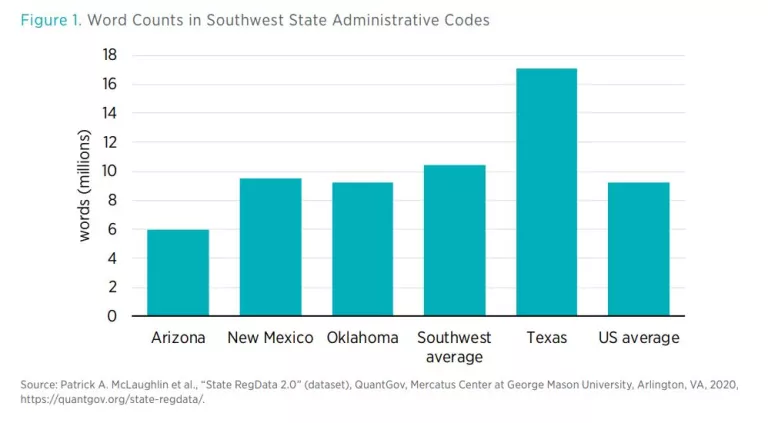
If one instead counts the restrictive terms in administrative codes, then Texas remains the most regulated Southwest state, with 263,369 restrictions (figure 2). Arizona is the least regulated state in the region by this metric, with just 64,319 restrictions.
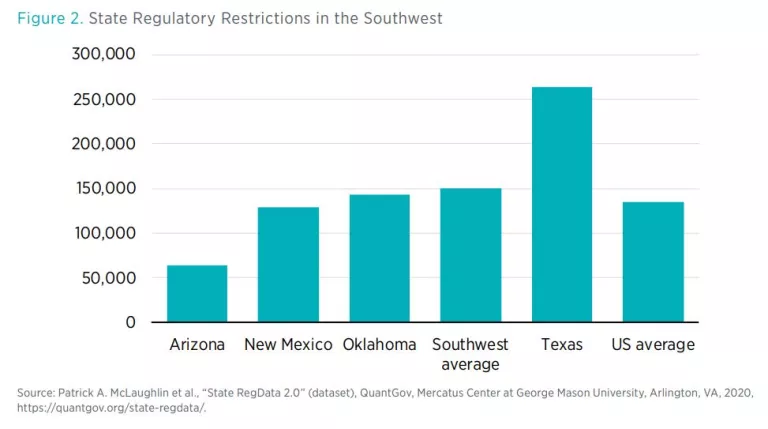
Regulation of Industry at the State and Federal Levels
Another way to analyze the regulatory systems in these states is to look at industries that are targeted by state and federal regulation. RegData utilizes machine learning algorithms that are trained to identify text relevant to particular industries. When the probability that a certain piece of legal text applies to a particular industry is combined with regulatory restriction data, one can produce an estimate of the regulatory restrictions targeting particular sectors of the economy. Figure 3a provides state regulatory restriction information for select industries. Figure 3a shows clearly that the number of industry-relevant regulatory restrictions varies widely both within and across states. In other words, for particular industries, some states impose far more regulation than others. And within different states, some industries are far more regulated than others.
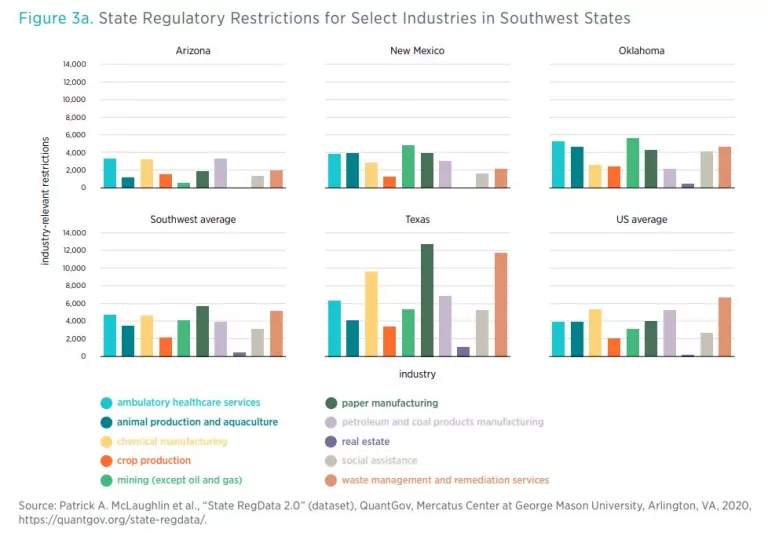
Several interesting observations can be made about the data in figure 3a. For example, Texas tends to impose more regulation on these industries than do the other states, which is consistent with its larger overall volume of regulations. Real estate is relatively lightly regulated across these states. Mining (except oil and gas) is the most regulated of these industries in New Mexico and Oklahoma; yet this industry has relatively few restrictions in Arizona.
The variation in the number of restrictions on various industries across this region could be explained by the relative importance of each sector to each state’s economy. Without assuming any direct causal relationship between the volume of regulations that falls on an industry and that industry’s contribution to GDP, in figure 3b we present the percentage of state GDP associated with each of these industries for the four states. Chemical manufacturing contributes a larger share to the Texas economy than to the other states, and it is more regulated too. Real estate is relatively important in all the states’ economies and is lightly regulated in all states too.
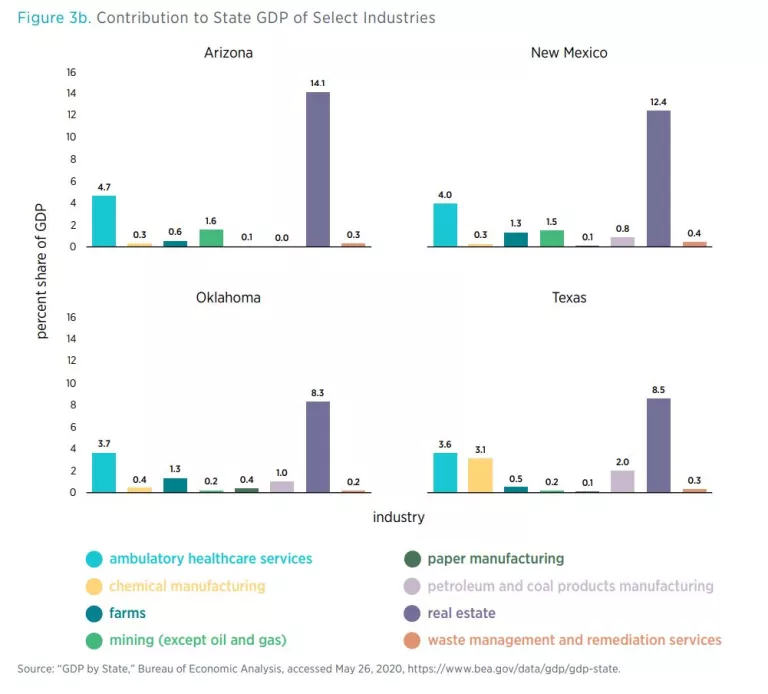
States also vary in terms of the degree to which their economies are targeted by federal regulation. For example, the average number of regulatory restrictions of the four states reviewed here is 149,810. By comparison, there are approximately 1.08 million regulatory restrictions in the US Code of Federal Regulations. Therefore, it is quite possible that federal regulations have a larger impact on these state economies than do the states’ own regulatory restrictions.
The Mercatus Center has also produced data to better understand the degree to which federal regulation targets states. By weighting estimates of industry-relevant federal restrictions according to how important various industries are to states’ gross state product, the Federal Regulation and State Enterprise (FRASE) index is able to rank the states in terms of how regulated they are by the federal government (figure 4). Texas receives a score of 1.12. This ranking is scaled relative to the nation as a whole, which receives a score of 1.00, so a score of 1.12 means that Texas industries are targeted by federal regulation 112 percent as much as industries across the nation as a whole are. On average, the states in the Southwest are, by this measure, about as regulated as the nation as a whole.
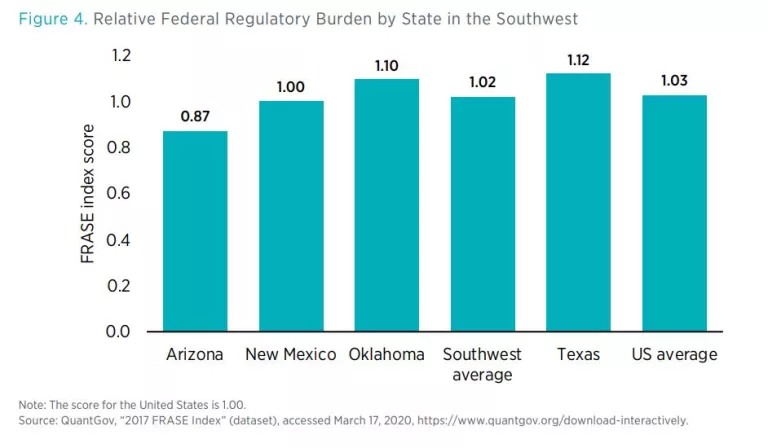
Regulation and Population
There are also reasons to speculate that more populous states might tend to have more regulation than less populous states. For example, more populous states might have more industries, so some forms of regulation may not be necessary in less populous states. It is possible that more populous states have denser populations than less populated states, and when more people are congregated in smaller areas, certain externalities or other market failures could be more prevalent, thereby necessitating more regulation. It may be that larger populations demand more regulation. Finally, some scholars have posited that there are fixed costs associated with regulating and that larger populations will be able to absorb these fixed costs more easily by spreading them across a greater number of people. Therefore, as population increases, it becomes relatively cheaper to impose regulations, and hence the quantity of regulations tends to increase.
For these reasons, it could make sense to adjust for population when reporting regulatory restrictions. Figure 5a shows that New Mexico is the most regulated state in the Southwest, adjusting for population, with 61.50 restrictions per 1,000 people. By this measure, Arizona remains the least regulated state in the Southwest, with just 8.84 restrictions per 1,000 people. On average, the Southwest is less regulated on a per-capita basis than the United States is as a whole.
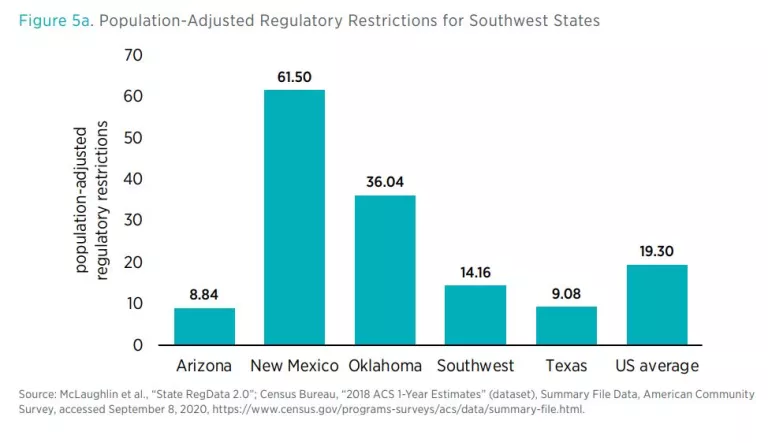
Figure 5b shows the GDP per capita for each of the states. Again, we stress that we are not attempting to establish a causal relationship between regulation and GDP, but merely putting the volume of regulatory restrictions in the context of the local economies.
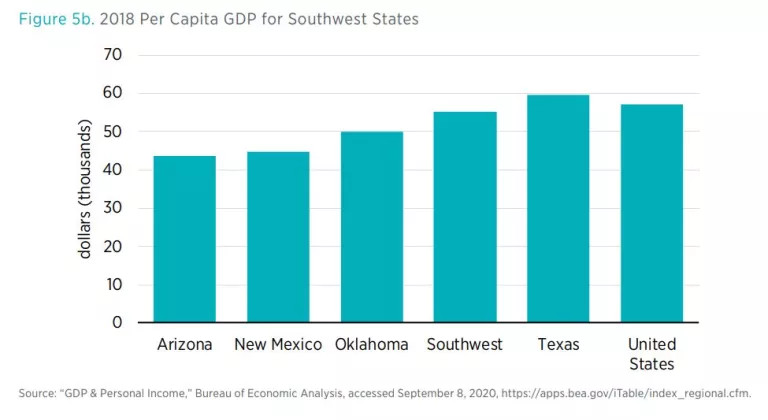
Conclusion
There are a variety of ways in which one can compare the regulatory environments across states, as this policy brief has done for states in the US Southwest. We have looked at word counts in state administrative codes, regulatory restriction counts, restrictions targeting industries in these states, the extent to which federal regulation targets each state’s industries, and the population-adjusted quantity of state regulation.
Each of these metrics has its own advantages and disadvantages. All told, the amount of regulation in the states is considerable. Further research will help gauge how levels of regulation are evolving in these states over time and what implications follow from this evolution. This snapshot of state regulations, however, provides a glimpse into the reach of various kinds of regulation in the US Southwest.

